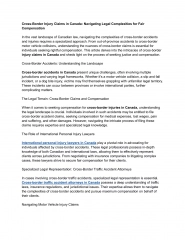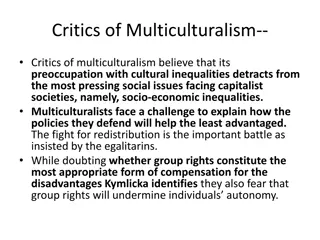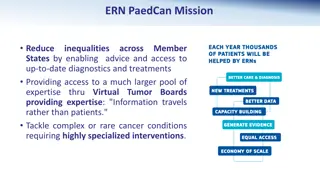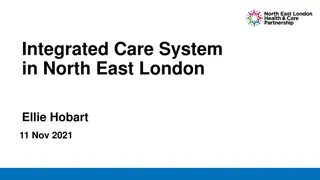Understanding Cross-Cultural Issues in Integrated Healthcare
Explore the impact of cultural diversity on healthcare, including demographic trends, health disparities, and cultural competence. Learn practical methods for enhancing cultural competency within healthcare teams to address disparities effectively.
Download Presentation

Please find below an Image/Link to download the presentation.
The content on the website is provided AS IS for your information and personal use only. It may not be sold, licensed, or shared on other websites without obtaining consent from the author. Download presentation by click this link. If you encounter any issues during the download, it is possible that the publisher has removed the file from their server.
E N D
Presentation Transcript
Cross-Cultural Issues in Integrated Care Module 8 James J. Werner, PhD, MSSA Case Western Reserve University
Learning Objectives 1. 2. Understand the effects of current demographic trends on U.S. healthcare Understand the impact of health disparities on prevalence of disease among racial/ethnic groups Learn why cross-cultural education for healthcare providers is an important method for addressing health disparities Learn practical methods for improving cultural competence among members of an integrated healthcare team Understand how to infuse cultural competency into all stages of the 5 A s model Learn to use teach-back with diverse patients to check for understanding 3. 4. 5. 6.
Culture Patterns of learned and shared behaviors and beliefs characteristic of a particular social, ethnic, or age group. Includes ways of thinking, communicating, interacting, and views on roles, relationships, customs, and values. Includes beliefs and attitudes about race, ethnicity, gender, age, sexual orientation, religion, disability status, socioeconomic status, geographic location, and other characteristics
Increasing Cultural Diversity in U.S. Racial /Ethnic Group* White Black/Af. Amer. Asian Hispanic 2000 % 75.1 12.3 3.6 12.5 2010 % 72.4 12.6 4.8 16.3 Change % - 2.7 + 0.3 + 1.2 + 3.8 *Figures for racial groups and Hispanic ethnicity are not mutually exclusive.
Demographic Projections1,2 The Latino population, already the nation s largest minority group, will triple in size through 2050. Hispanics will make up 29% of the U.S. population in 2050, compared with 16% in 2010. Whites will become a minority (47%) by 2050. Nearly one in five Americans (19%) will be an immigrant in 2050, compared with one in eight (12%) in 2005.
Health Disparities3 Despite demographic trends, disparities in outcomes for minority groups are evident in virtually all measures of health. Differences remain after adjustment for socioeconomic and healthcare access factors. Examples (from Year 2000): White Black/AA Difference Heart disease (Mortality per 100,000) 255.5 325.8 70.3 Cancer (Mortality per 100,000) 200.6 248.5 47.9 HIV (Infections per 100,000) 6.76 60.45 53.69
Disparities in Behavioral Healthcare4 African, Asian, Native, and Latino Americans needing outpatient mental healthcare are less likely to receive it than Whites. African Americans, Latinos, Asian Americans, and Native Americans are more likely than Whites to leave mental health treatment prematurely. African Americans and Latinos are less likely than Whites to receive guideline- adherent treatment when suffering from anxiety disorders and depression. African Americans are overrepresented among persons suffering from serious mental illness who fail to receive minimally adequate treatment. African Americans and Latinos have proved to be less likely than Whites to receive a prescription for psychotropic medication. When they are prescribed psychotropic medications, minority individuals are more likely to receive high doses.
Causes of Health Disparities The sources of these disparities are complex, are rooted in contemporary and historic inequities, and involve many participants at several levels, including health systems, their administrative and bureaucratic processes, utilization managers, healthcare professionals, and patients. 5
Discussion Have you observed or experienced any form of discrimination by: healthcare systems individuals working within bureaucracies healthcare professionals? What happened? How could it have been prevented?
Cross-Cultural Education of the Healthcare Workforce Cross-cultural education is a key intervention strategy in reducing health disparities Research studies have demonstrated its effectiveness on patient satisfaction, medication adherence, and health outcomes. Three Primary Approaches Address attitudes: cultural sensitivity, awareness, approach Increase knowledge: multicultural/categorical approach Develop skills: cross-cultural approach
Three Models Cultural competence: The level of a provider s knowledge, attitude, and skills about cultural values and health-related beliefs, disease incidence and prevalence, and treatment efficacy for diverse cultural groups. Cross-cultural efficacy: Providers learn how their own culture and behaviors can impact others of different cultures, and understand how patients culturally-based behaviors may impact the provider. Cultural humility: Provider engages in regular self-evaluation and self-critique. Goal is to developed power-balanced relationships with patients of different cultures.
Shared Objectives The models share the ultimate goal of preparing providers to manage sociocultural issues that emerge Cultural skills training programs often utilize elements of all 3 models Each model requires attention to knowledge, attitudes, and skills. The umbrella term cross-cultural competence will be used to encompass these models
Improving Your Cross-Cultural Competence Knowledge General For the specific populations you work with, become knowledgeable of: cultural beliefs behaviors and common practices attitudes toward healthcare and health-seeking behaviors Specific By inquiring, learn the specific preferences of individual patients and families you serve
Improving Your Cross-Cultural Competence (Cont d) Knowledge (continued) Understand that cultures are diverse within themselves All cultures share both similarities and differences
Improving Your Cross-Cultural Competence (Cont d - 2) Attitudes Self-Reflection Enhance self-awareness of your own attitudes and beliefs in order to minimize the influence of stereotypes on your practice Become aware of possible feelings of anger toward perceived preferences, guilt about disparities, denial of differences, or tendency to blame the victim. These are not unusual attitudes. Discuss your attitudes in a non-judgmental context and seek to understand them
Improving Cross-Cultural Competence Skills Learn to ask appropriate questions about race, ethnicity, family, religion, relationships, immigration experiences, social support, healthcare beliefs, & health-seeking behaviors Become proficient in the use of language interpreters Extend cultural competence skills to working as a member of a healthcare team comprised of different health professions
Improving Cross-Cultural Competence (Cont d - 3) Extend cultural competence to your work as a member of a integrated healthcare team Multiple types of diversity among providers Provider type diversity: physicians, nurse practitioners, physician assistants, registered nurses, licensed practical nurses, medical assistants, social workers, psychologists, etc. Racial and ethnic diversity Diversity in age, gender, sexual orientation, disability status, socio-economic status, indigenous heritage, national origin
Discussion Have you received training (workshop, seminar) in cultural competency or a similar diversity training model in a workplace setting (including field placement)? Was the training helpful in your work? If so, how? If not, why not? How was the training received by other staff members? How could the training have been improved?
5 As Model A Flexible, Patient Centered Approach Integrated approach to assessment and intervention Well-established & evidence-based Familiar to PC clinicians & PC teams Highly adaptable to the preferences of patients
5 As Model 1) Assess Risk factors, behaviors, symptoms, attitudes, preferences 2) Advise 5) Arrange Specify options for treatment, how symptoms can be decreased, & how functioning & quality of life can be improved Specify plans for follow- up (visits, phone calls, e- mail reminders) Personal Action Plan 1. List goals in behavioral terms. 2. List strategies to change health behaviors. 3. Specify follow-up plan. 4. Share the plan with the healthcare team. 3) Agree 4) Assist Collaboratively select goals based on patient interest and motivation to change Provide information, teach skills, and help problem-solve barriers to reach goals
Cross-Culturally Competent Integrated Behavioral Healthcare using the 5A s The following cross-cultural elements of the 5 A s can be integrated into the corresponding components of the comprehensive 5 A s model. Alternatively, the following cross-cultural elements can be integrated into other frameworks for behavioral health assessment and intervention.
Cross-Culturally Competent Integrated 5As Model Assess Increase the patient s trust through openness and transparency Use interpreters if they would be helpful in improving communication Obtain training to optimize the use of interpreters Use an introductory script: explain who you are, what will happen during the appointment, who will have access to information Ask if the patient has any questions about you, your role, and how their information might be used If the patient seems reticent, sensitively inquire about the patient s concerns
Cross-Culturally Competent Integrated 5As Model (Cont d - 2) Assess (continued) Seek to understand the patient s faith and customs Before we begin, are there any religious beliefs or spiritual values, traditions, or customs that are important for me to know about so that I can understand your current situation?
Cross-Culturally Competent Integrated 5As Model (Cont d) Assess (continued) Learn about the patient s culture through inquiry. What country did you grow up in? Where do you live now? Which neighborhood? What language do you speak at home? Which language are you most comfortable speaking? Are there differences between healthcare system where you grew up compared to health care here? How are they different? Do they have behavioral healthcare providers in your native country? If so, what are your attitudes about them?
Cross-Culturally Competent Integrated 5As Model (Cont d - 3) Assess (continued) Learn about the patient s thoughts and beliefs about the presenting problem How does this problem affect your family? Do your friends and family see the problem as you do, or do they see it differently?
Cross-Culturally Competent Integrated 5As Model (Cont d - 4) Advise & Agree Seek to understand what has worked previously for this patient, so that potential solutions come from the patient and work in the context of their life and culture Describe the options for the intervention on the basis of assessment data using language that can be readily understood by the patient (check for understanding) If possible, use a language interpreter if it would enhance communication (ideally bi/multi-cultural)
Cross-Culturally Competent Integrated 5As Model (Cont d - 5) Assist Assist the patient in addressing any barriers to the intervention plan Is there anything that might make it difficult to carry out the plan? Are there any friends or family members who may not like the changes you plan to make? How will the changes you re planning be perceived by people in your neighborhood, church, or social group?
Cross-Culturally Competent Integrated 5As Model (Cont d - 6) Arrange Check for the patient s understanding of the intervention plan using the teach back method We ve covered a lot today, and I just want to make sure that we re both clear about the plan. Can you tell me, in your own words, what our plan is?
Questions? Comments?
References 1. U.S. Population Projections: 2005-2050, Pew Research Center. http://www.pewsocialtrends.org/2008/02/11/us-population-projections-2005-2050/ 2. 2010 U.S. Census Briefs. Overview of Race and Hispanic Origin: 2010. U.S. Census Bureau. http://www.census.gov/prod/cen2010/briefs/c2010br-02.pdf 3. Satcher, D., Pamies, R.J., & Woelfl, N.L. (2006). Multicultural Medicine and Health Disparities. New York: McGraw Hill. 4. Snowden, L. R. (February, 2003). Bias in Mental Health Assessment and Intervention: Theory and Evidence. Am J Public Health. 93(2): 239 243. 5. Smedley, B.D., Stith, A.Y, & Nelson, A.R. (Eds.). (2003). Unequal Treatment: Confronting Racial and Ethnic Disparities in Healthcare. Washington, DC: National Academies Press. 6. Feldman, M.D., & Christiansen, J.F. (2008). Behavioral Medicine: A Guide for Clinical Practice. (3rd Ed.). New York: McGraw Hill. 7. Hunter, C.L., Goodie, J.L., Oordt, M.S., & Dobmeyer, A.C. (2009). Integrated Behavioral Health in Primary Care: Step by Step Guidance for Assessment and Intervention. Washington, DC: American Psychological Association. 8. Pew Research Center. U.S. Population Projections: 2005-2050. http://www.pewsocialtrends.org/2008/02/11/us-population-projections-2005-2050/ 9. Robertson, P., & Zeh, D. Cross-Cultural Issues in Integrated Care. In Curtis, R., & Christian, E. (Eds.). (2012). Integrated Care: Applying Theory to Practice. New York: Routledge.

 undefined
undefined






















